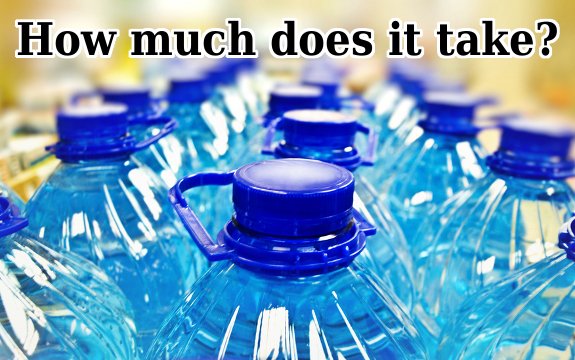How Much Water is Used to Make a Bottle of Water?

 Just how much water goes into making that bottle of water? It isn’t the amount you see labeled on the outside. Rather, it could take many times that amount to create the beverage that eventually finds its way to your grocer’s shelf. While the International Bottled Water Association (pdf) says they’ve determined bottled water doesn’t waste as much water as environmentalists have claimed, others say the IBWA isn’t looking at the whole picture.
Just how much water goes into making that bottle of water? It isn’t the amount you see labeled on the outside. Rather, it could take many times that amount to create the beverage that eventually finds its way to your grocer’s shelf. While the International Bottled Water Association (pdf) says they’ve determined bottled water doesn’t waste as much water as environmentalists have claimed, others say the IBWA isn’t looking at the whole picture.
The bottled water industry is frequently vilified for capitalizing on our one greatest resource, one that every person needs to survive. Just one aspect of that criticism rests in how wasteful the industry is.
In an effort to answer questions on how much water they waste, the IBWA commissioned a study which found North American bottled water companies use 1.39 liters of water to make a single 1 liter bottle of water. And while NPR points out that’s less than what’s required to make a liter of soda (2.02 L. water) and less than a liter of liquor (34.55 L. water), it’s still not completely accurate.
Rather than only looking at the amount used to produce the water, the IBWA needs to look at the water used throughout the supply chain. The Water Footprint Network says the bottle itself could require 3 liters of water for production. If you add in the amount of water needed to drill for the oil to make the petroleum-based plastic or the water to make the paper labels, you’re looking at a much larger “water footprint”. We throw away roughly 50 billion plastic bottles each year.
The bottled water industry says this is too much, that “you could extrapolate that ad infinitum,” according to Chris Hogan of the IBWA. He may be right, but at what point do you draw the line. Certainly if you are one of the world’s largest users of plastic bottles, the water used in making those bottles should be a concern of yours.
Bottled Water Deceptions
But this isn’t the first, and likely won’t be the last, study that questions the efficiency, need, and even morality of the bottled water industry.
The bottled water you find on store shelves, listed as spring or mountain water, goes through less vigorous testing than the water coming from your tap. It’s regulated by the FDA, as a food, whereas the water coming into your home is regulated and tested by the EPA (Environmental Protection Agency).
In testing by the Environmental Working Group, the bottled water industry was found to hide the sources of their water and make it difficult for consumers to learn about how the water was purified. In reality, about half of the bottled water offered on the shelves is nothing more than bottled municipal tap water.
When you add to all of this with the cost of bottled water, it becomes apparent that we’ve been fleeced on this industry. Though a bottle of water might be convenient when you’re out and about, it would be far better to plan in advance and bring your water in a glass or metal bottle from home.
